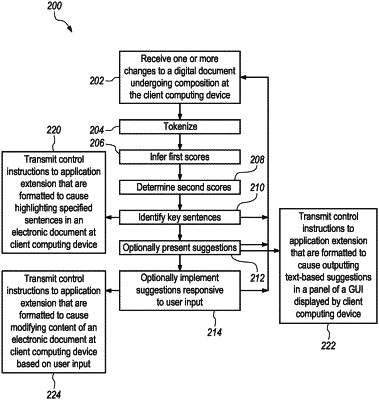| CPC G06F 40/166 (2020.01) [G06F 9/453 (2018.02); G06F 40/284 (2020.01); G06F 40/40 (2020.01)] | 20 Claims |

|
1. A computer-implemented method, comprising:
receiving a representation of a digital document at a server computer and electronically storing the representation in memory of the server computer, the digital document comprising a sequence of sentences arranged into one or more paragraphs, each sentence comprising one or more words in a natural language;
programmatically generating a document-specific vocabulary by tokenizing a set of all sentences comprising the sequence of sentences into a document-specific set of tokens;
programmatically inferring and outputting, by executing a trained machine learning model to evaluate the document-specific set of tokens, for each sentence of the sequence of sentences, a corresponding first score value representing a probability of that sentence being semantically important to an overall meaning of the digital document;
programmatically determining, by constructing a digital representation of a Knapsack optimization problem in server computer memory and executing solution instructions to solve the problem based on a plurality of heuristics and defined partly by a cost function and a value function, the functions being programmed as part of the solution instructions, for each sentence of the sequence of sentences, a corresponding second score value representing a likelihood of that sentence being read by a future reader of the digital document; and
transmitting, from the server computer to a client computing device via a network, first display instructions that are formatted to cause identifying one or more key sentences of the sequence of sentences based on each of the corresponding first score value and the corresponding second score value of each sentence of the sequence of sentences in a graphical user interface of the client computing device.
|